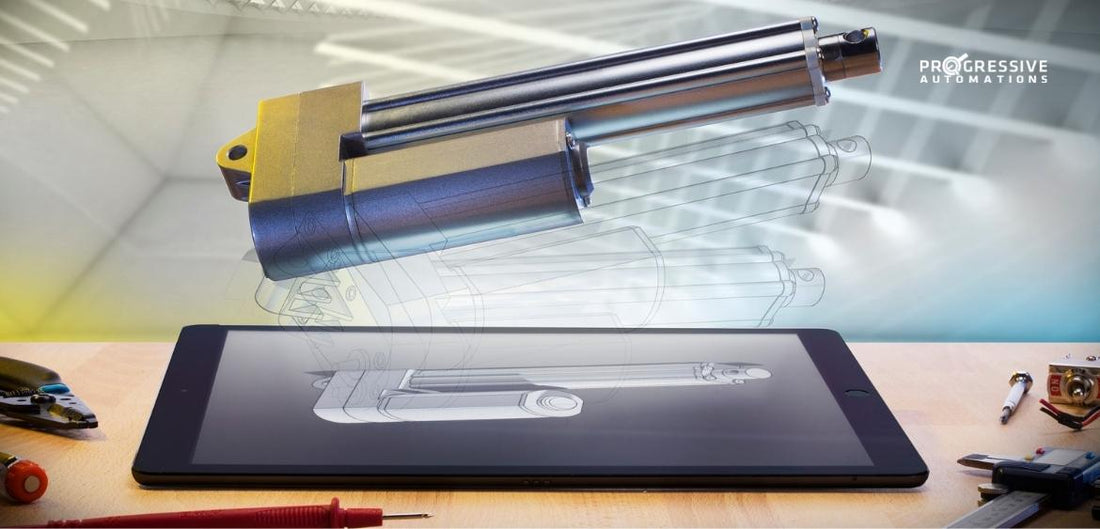Nearly every mechanical application we encounter involves moving parts and components that have a certain level of precision and accuracy requirements to ensure proper operation. This is especially the case when it comes to equipment and machinery involving electric linear actuators. Factors such as backlash, build tolerance, mounting alignment, and application dynamics can greatly affect the precision and accuracy of linear motion systems using electric linear actuators. In this article, we will cover the crucial aspects of precision and accuracy that need to be considered when integrating electric linear actuators in any application.
What is Actuator Precision and Accuracy?

For electric linear actuators, the ability to reach the goal position as close as possible is considered accuracy while precision represents the ability to replicate the same results relative to each other every time. Accuracy is used to measure the error between the goal position vs the achieved position. Precision is for measuring the error range between how far off all the previously achieved positions were from each other.
An archery target can be used as an analogy to describe the difference between precision and accuracy for actuators where the actuator’s goal position is represented by the center of the target (bullseye). High accuracy and low precision can be seen when an actuator can get quite close to the goal position, however, it may not land on the same spot every time.

Low accuracy and high precision can bee seen when the actuator does not reach the goal position but is able to consistently travel to the same position it was previously at over and over.

In an ideal world, a combination of high precision and accuracy will result in an actuator that travels to the goal position and is able to consistently reach the same spot over and over.

Build Tolerance in Parts Manufacturing and Actuators

The build tolerance of an actuator is one contributing factor that can affect the precision and accuracy once installed. During the manufacturing process of any product, most mass-produced items will have some physical limitation to how close a manufacturer can replicate the listed specifications. Most of our general-purpose actuators have a build tolerance of +/- 3mm, however, it is important to reach out to us or the manufacturer of any item you purchase if your application will be sensitive to precision and accuracy.
It's also crucial to be aware that a linear actuator's precision and accuracy once fully installed may be affected due to a variety of circumstances outside the unit itself. Other components used in a system may also have some build tolerance which can introduce another source of error when installed with an actuatorbsuch as:
- Pulleys
- Mounting brackets
- Rods
- Bushings
- Valves
- Framing materials
- Bearings
Backlash In the Use of Linear Actuators

Backlash, which is also known as lash, play, or slop, is a lost motion or clearance in a mechanism due to the gaps between each of the pieces such as what is seen from the distance between mated gear teeth. As we try to reverse the turning direction of rotating gears, we’ll see that the lost motion or slack is taken up before the gears will start reversing direction. This phenomenon from internal gears is one of the reasons why actuator backlash is quite common and can vary in range depending on the model of your actuator.

Framing, mounting brackets, and other attachable accessories may also be designed with some play to allow for pivot points and the proper intended operation. The slight play can add on top of the actuator backlash that was already present and may further reduce overall precision and accuracy.
Positional errors can also happen due to non-mechanical sources of errors such as the potentiometer feedback, hall sensors, and motor drivers being used for controlling and reading positions of an actuator through programming. Dead time and other timing delays that may occur from the control system should also be considered for applications requiring high precision and accuracy.
To account for general wear and tear, performing regular inspections as part of overall system maintenance and making the necessary adjustments for tuning can help increase long-term precision and accuracy. Even if the worst-case scenario rarely occurs when all tolerances are at their maximum, it's crucial to consider all potential tolerances for a thorough comprehension of the system and an assessment of potential faults.
How Important Are Precision and Accuracy?

The importance of precision and accuracy can vary depending on the use case of the electric linear actuators. Certain applications may find precision and accuracy equally important, while others may find the relative importance of one to be greater than the other. While using components with high precision and accuracy may be possible, doing so when it was not necessary will increase overall costs and system complexity for no major benefit. Below are a few examples that reflect how the importance of precision and accuracy can vary:
- Automated furniture – Locking and unlocking the doors of large wooden cabinets by sliding a latch with actuators will not need much precision or accuracy for latching mechanisms that have lots of room for play.
- Home automation – Automated glass windows with actuators may not require much accuracy since the user can just adjust its initial position during installation but will require precision so it can reach the same position each time.
- Food industry – Actuators used in pizza topping dispensers don’t need precision to travel to the exact same spot every time but will require accuracy so that the toppings successfully land on the intended area of the pizza.
- Medical applications – Robot-assisted surgery and fluid dispensers for making medicine use models such as our PA-12-R and PA-12-T Micro Precision Actuators since high levels of precision and accuracy are critical.
Actuators that are used for basic tasks tend not to require high levels of precision and accuracy to operate within their requirements and may be better off with standard model actuators for overall simplicity and cost-effectiveness. Most general applications may require precision but not accuracy, or vice versa depending on the exact use case. In more specialized applications, both precision and accuracy can become critical for proper operation. As a result, it's critical to fully understand your application requirements as well as any potential effects that installation, orientation, and tolerances may have on the system's precision and accuracy.
IN SUMMARY
Electric linear actuators can come with varying levels of precision and accuracy; however, it is also important to account for other sources of errors that are part of your overall system. By fully verifying the precision and accuracy requirements of your application, you can then choose the components and integration techniques that will be suitable and later design around their limitations.
We hope you found this article informative, especially if you were looking to know how precision and accuracy play a role in the use of linear actuators. If you have any queries or wish to discuss our products further, please do not hesitate in reaching out to us! We are experts in what we do and will be happy to assist in any way we can.
sales@progressiveautomations.com | 1-800-676-6123




